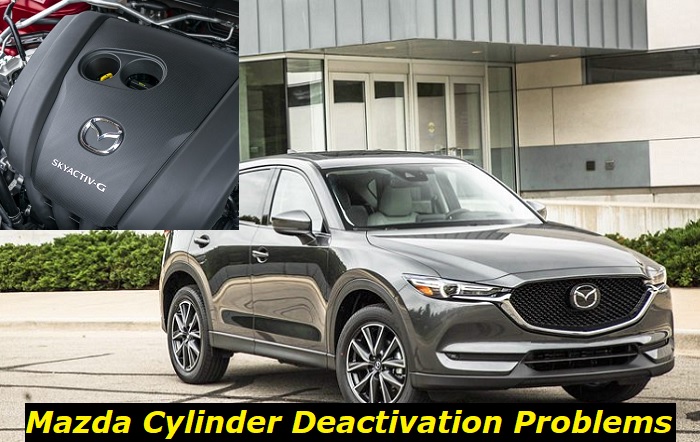Mazda is one of the largest automakers in the world, having produced over 1.5 million vehicles all over the world. This Japanese brand, which started as the Toyo Cork Kogyo Co., Ltd, became a household name way back in the early 30s. Some of its famous models include the Mazda 2, Mazda 2 Hybrid, Mazda 3, and the SUV crossovers like CX-3, CX-5, CX-30, CX-60, and MX-30.
Cylinder deactivation system problems highlights
- Level of importance:Medium
- Commonreasons:Internal problems in the system, leaks, electrical issues
- DIY inspection:Impossible
- DIY repair:Impossible
- Price for repair:$250 - $800
- Can you drive?Yes, butthe power may be limited
- Ways to fix:Only professional repair is possible

What is Cylinder Deactivation
Making sure that no fuel is used at all is among the best and simplest ways to make each drop go further. Cylinder deactivation, which temporarily turns off some cylinders of larger engines when operating at low load, operates on that theory. The engine control electronics of the car manage this process on-the-fly.
The hit-and-miss engine is the variable-displacement engine's earliest-known technological predecessor. Most vehicles with six and eight-cylinder engines use the technology, including the Mazda 2 Hybrid, CX-60, MX-30, and Flair Crossover. It is also utilized in some Mazda small four-cylinder engines and other vehicles that switch from three to two cylinders while cruising at light throttle.
Different techniques are used by car manufacturers to start cylinder deactivation, but in essence, it involves freezing the valves. This procedure typically allows the flow of fuel and air into specific cylinders, limiting the number of cylinders in which combustion occurs. In actuality, it is now a much smaller engine.
The computer system in the car cleverly controls this process by sensing when you may require an extra oomph of power and restarting all cylinders for maximum power. The only way to detect the process is typically through a light on the instrument cluster because it is essentially imperceptible. It's a clever process that lessens fuel inefficiency, although it doesn't actually increase fuel efficiency.
Common Mazda Cylinder Deactivation Problems
If you may recall, in the middle of 2019, Mazda issued a recall for about 262,000 cars and SUVs. The 2019 Mazda3, 2018-2019 Mazda6, and 2018-2019 CX-5 are the models covered by this recall. Except for 2,651 Mazda3s that were made in Mexico, almost all of the vehicles were made at Mazda's factory in Japan.
Although it was never widely used, cylinder deactivation is not exactly a new engine technology. Many automakers used it for the first time on some models more than 20 years ago. But in reality, the early cylinder deactivation systems operated harshly and were incredibly prone to malfunctions. As a result, the majority of users disliked and mistrusted cylinder deactivation systems.
Since many automakers like Mazda worked diligently to eliminate the bugs, modern cylinder deactivation systems are now largely trustworthy. The fact that piston rings require both combustion and compression pressure to function was one issue that was addressed. This is because rings' spring tension is insufficient to push them firmly against the cylinder walls to create and maintain a positive seal between their sealing surfaces and the walls.
Eight oil control solenoids are actually used in the cylinder deactivation system, and they each operate both valves on each cylinder. The control system shuts off the fuel supply to any given cylinder when it is deactivated, but only after combustion has occurred in that cylinder.
As mentioned earlier, pressurized oil and solenoids are used in all cylinder deactivation systems. This is why the proper operation of all such systems depends on the provision of uncontaminated oil. In fact, problems with oil supply and pressure control are the main causes of problems with these systems.
- Faulty spark plugs and/or uncontrolled oil consumption
The amount of oil used has been somewhat reduced thanks to the exhaust gas being trapped in inactive cylinders. Despite this advantage, many Mazda vehicle owners still feel that their vehicles' oil consumption is excessive despite having cylinder deactivation. In fact, increased oil consumption typically becomes apparent after traveling about 30,000 miles.
Determining whether some oil is going through the PCV system and into the intake structure is essential in fixing this issue. Also, you may confirm that the pressure relief valve for the AFM system, which is situated in the cylinder head or crankcase, is not allowing oil spray or mist to enter the intake system. Due to the spark plugs' overheating, leaking oil also proceeds in spark plug fouling and failures.
Replacing the tappet with newly designed ones and installing a device to deflect oil are other potential solutions to these issues. Adding an oil detector near the valve that relieves pressure stop oil mist from entering the valve. Some solutions include disassembling the engine to tidy up the grooves on the pistons or changing the pistons.
- Mechanic noises and misfires
Regardless of the application or manufacturer's involvement, these cases are usually brought on by dirty or contaminated degraded engine oil. The issue is that the electronic control unit will still use various strategies controlled by the torque to ensure the driver won't notice the change to reduced power, even though one or more cylinders may mess up.
For all cylinders that haven't been deactivated, the electronic control unit will keep on implementing all necessary strategies. This might cause the car to stumble or surge. Severe misfires, noises resembling valve lifters, and other mechanical noises are also possible symptoms, especially in Mazda models.
Remember that there aren't any simple or fast solutions for Mazda misfires and problems with mechanic noises. However, removing oil sludge may be done frequently, which will necessitate disassembling the damaged parts. Other potential solutions include the utilization of extremely sophisticated mountings on the engine and noise reduction through audio systems installed in your Mazda.
- Sensing the transition
Several Mazda owners claim that switching between reduced-power and normal mode is very noticeable. Because of this criticism, Mazda developed software upgrades that included several techniques to ease the transition. Other solutions may involve brief adjustments to fuel delivery and ignition timing and modifying permissive conditions to limit how frequently the cylinder deactivation system operates.
Conclusion
Customers usually complain about excessive oil consumption when they use cylinder deactivation systems. It is crucial to acknowledge and comprehend that the consumption of oil is an essential component of these systems' operation. Educating other Mazda owners on how these things work can greatly reduce common problems.
About the authors
The CarAraC research team is composed of seasoned auto mechanics and automotive industry professionals, including individuals with advanced degrees and certifications in their field. Our team members boast prestigious credentials, reflecting their extensive knowledge and skills. These qualifications include: IMI: Institute of the Motor Industry, ASE-Certified Master Automobile Technicians; Coventry University, Graduate of MA in Automotive Journalism; Politecnico di Torino, Italy, MS Automotive Engineering; Ss. Cyril and Methodius University in Skopje, Mechanical University in Skopje; TOC Automotive College; DHA Suffa University, Department of Mechanical Engineering






Add comment